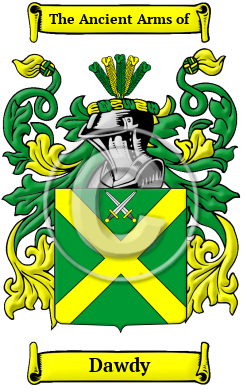| ![Show Contents]() Dawdy History, Family Crest & Coats of Arms Dawdy History, Family Crest & Coats of Arms
- Origins Available:
Ireland
Etymology of DawdyWhat does the name Dawdy mean? The original Gaelic form of Dawdy was Ó Dubhda. The first portion of the name comes from the word dubh, which means black or dark complexioned. (O'Hart) Early Origins of the Dawdy familyThe surname Dawdy was first found in County Mayo (Irish: Maigh Eo) located on the West coast of the Republic of Ireland in the province of Connacht. King Niall, brother of Fiachra and descended from Daithi, was one of the last pagan Kings of Ireland. For centuries they were the leading sept of northern Ui Fiachrach. Their territory comprised the baronies of Erris and Tirawley in the county of Mayo and Tireagh in Sligo. 1 They were the traditional Princes of Hy-Fiachra in Connaught. (O'Hart) Early History of the Dawdy familyThis web page shows only a small excerpt of our Dawdy research. Another 231 words (16 lines of text) covering the years 1354, 1579, 1656, 1706, 1813 and 1891 are included under the topic Early Dawdy History in all our PDF Extended History products and printed products wherever possible. Dawdy Spelling VariationsJust like the English language, the Gaelic language of Ireland was not standardized in the Middle Ages. Therefore, one's name was often recorded under several different spellings during the life of its bearer. Spelling variations revealed in the search for the origins of the Dawdy family name include Dowd, Duddy, Doody, O'Dowd, Dowdy, Dowdie, Doudy, Doudie, Doudd, Doodie and many more. Early Notables of the Dawdy familyFather John O'Duada (d. 1579) one of many Irish Franciscan martyrs when he was tortured and hanged in 1579; and Samuel Doody (1656-1706), an early English botanist, born in Staffordshire 28 May 1656, the eldest of...
Another 35 words (2 lines of text) are included under the topic Early Dawdy Notables in all our PDF Extended History products and printed products wherever possible.
| Dawdy migration to Canada | + |
Death and immigration greatly reduced Ireland's population in the 19th century. For the native Irish people poverty, hunger, and racial prejudice was common. Therefore, thousands left their homeland to seek opportunity in North America. Those who survived the journey and the quarantine camps to which they arrived, were instrumental towards building the strong developing nations of the United States and the future Canada. By far, the largest influx of Irish settlers occurred with Great Potato Famine during the late 1840s. These were employed as construction or factory workers. An examination of passenger and immigration lists has shown early immigrants bearing the name Dawdy: Dawdy Settlers in Canada in the 18th Century- Capt. James Dawdy U.E. who settled in Canada c. 1784 2
| Contemporary Notables of the name Dawdy (post 1700) | + |
- Bob Dawdy, American guitarist, known for his work with The Velaires, an American rock and roll band from Sioux City, Iowa
- Cheryl Dawdy, American singer/songwriter, known for her work with The Chenille Sisters, an American contemporary folk band
- Shannon Lee Dawdy (b. 1972), American historian, archeologist, anthropologist and associate professor at the University of Chicago
- MacLysaght, Edward, Irish Families Their Names, Arms and Origins 4th Edition. Dublin: Irish Academic, 1982. Print. (ISBN 0-7165-2364-7)
- Rubincam, Milton. The Old United Empire Loyalists List. Genealogical Publishing Co., Inc, 1976. (Originally published as; United Empire Loyalists. The Centennial of the Settlement of Upper Canada. Rose Publishing Company, 1885.) ISBN 0-8063-0331-X
 |

